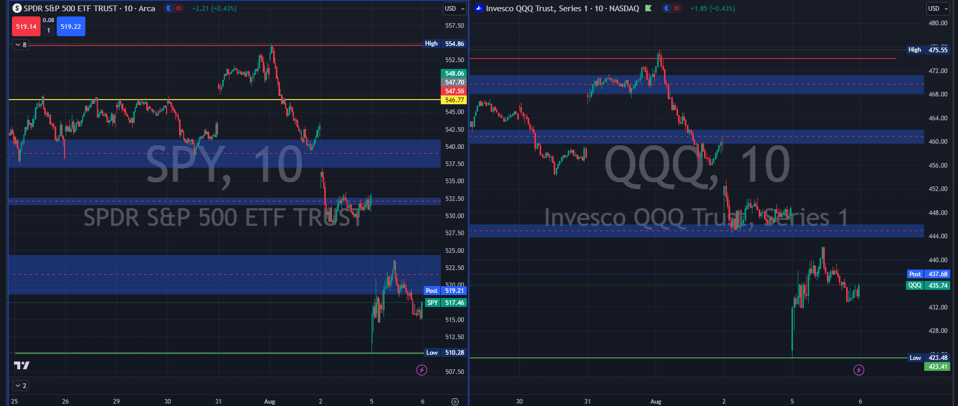Market Review 5th August 2024
Simplify the craziness
DAILY REVIEW
N
4 min read
The start of the week has seen a significant pullback in stock markets, exacerbated by a combination of weak U.S. jobs data, rising recession concerns, and geopolitical tensions. Here's an in-depth analysis of the recent market movements and their potential implications.
Market Performance Overview
After a 2% decline last week, equity markets continued their downward trend on Monday. The S&P 500 experienced a sharp 3% drop, while the Dow Jones Industrial Average and Nasdaq Composite lost 2.6% (1,034 points) and 3.4%, respectively. This divergence highlights the substantial impact of technology stocks on the broader market.
The decline in technology and growth stocks, particularly industry leaders like Apple and NVIDIA, was a major contributor to the overall market downturn. Defensive sectors managed to hold up slightly better, though all sectors ended the day in negative territory.
Factors Behind the Market Decline
Recession Concerns:
The latest U.S. jobs report, which fell short of expectations, has fueled fears of an impending recession. Nonfarm payrolls in July increased by only 114,000, significantly below the anticipated 175,000. The unemployment rate also ticked higher to 4.3%, its highest since 2021.
Additionally, the number of people working part-time for economic reasons rose to 4.6 million, aligning with pre-pandemic levels and indicating potential weaknesses in the labor market.
Global Market Reactions:
The negative sentiment extended to global markets, with Japan's Nikkei index plummeting by 12%. This sharp decline can be attributed to Japan's recent interest rate hikes, contrasting with the looser monetary policies of other major central banks. The resulting disruptions in the Japanese yen and currency markets have likely contributed to the Nikkei's underperformance and may have spillover effects on global financial markets.
Sector-Specific Declines:
Technology and communication services sectors, which had been market leaders for much of the year, were notable laggards on Monday. Bellwether stocks like Apple and NVIDIA experienced significant declines, dragging down the overall equity indexes.
Defensive sectors, while performing relatively better, still ended the day lower, reflecting the broad-based nature of the market sell-off.
Bond Market Dynamics:
Amid the equity market turmoil, bonds provided a safe haven for investors. U.S. Treasuries rose, pushing the 10-year yield below 3.8% for the first time in over a year. The yield on the Government of Canada 10-year bond hovered just above 3%.
The rally in bond markets suggests a shift to "risk-off" sentiment, with investors seeking refuge in safer assets amid rising economic uncertainties.
Geopolitical and Political Uncertainties:
Geopolitical tensions, particularly in the Middle East, have added to the cautious market sentiment. Threats of an Iranian retaliatory strike on Israel heightened concerns on Monday, contributing to the overall risk aversion.
U.S. political uncertainties, including debates over fiscal policy and upcoming elections, have further compounded the cautious mood among investors.
Key Takeaways from the Recent Sell-Off
Despite the abrupt nature of the recent market decline, it does not necessarily signal a new, broader direction for the markets. Here are some key takeaways:
Recession Fears May Be Overstated:
While recession worries have dominated headlines, the actual increase in the probability of a recession may be less significant than perceived. The U.S. jobs report, though underwhelming, does not indicate a collapsing labor market or a consumer poised for hibernation. The economy appears to be slowing, but calls for an imminent recession may be premature.
Technology's Role in the Decline:
Mega-cap technology stocks, which led the market rally earlier this year, are now leading the decline. The recent pullback can be seen as a natural correction in the most overheated segments of the market, rather than an indiscriminate sell-off across all sectors.
Potential Stabilizing Factors:
The current market environment may solidify the Federal Reserve's ability to initiate a rate-cutting cycle in September. More accommodative monetary policies and the corresponding drop in longer-term interest rates should provide support to the economy.
While debates will continue over the Fed's responsiveness, easier monetary policies typically offer a favorable tailwind for financial markets.
Perspective on Market Volatility:
Volatility is a normal part of market behavior and can be healthy for long-term market stability. Historically, the stock market experiences several 5% dips and one 10% correction per year. Prior to the recent decline, the market had only seen one 5% pullback in 2024.
Despite the recent drop, the S&P 500 is still up over 8% for the year and has gained more than 25% since the pullback last October.
Conclusion: Navigating Market Volatility
In summary, while the recent market pullback is uncomfortable, it does not necessarily signal a deterioration in the fundamental foundation of the current bull market. The economy does not appear poised to tip into a recession soon, corporate profits are on the rise, and both the Bank of Canada and the U.S. Federal Reserve are pursuing easier monetary policies.
Investors should remain cautious but avoid making hasty decisions based on short-term market movements. The recent decline may persist for a while as the market adjusts, but the underlying factors supporting the bull market remain intact. Maintaining a balanced portfolio and staying focused on long-term investment goals will help navigate through this period of heightened volatility.
As always, staying informed and considering the broader economic context will be crucial for making sound investment decisions. The current market environment underscores the importance of diversification and a disciplined approach to investing.


